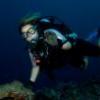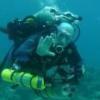
Buoyancy control techniques
#1

Posted 20 October 2008 - 09:01 AM
#2

Posted 20 October 2008 - 09:55 AM
1. Try to find your sweet spot with weights - any extra requires air in your BC you can't breathe (yea, I know, in an emergency you can) -Diving in Wakatobi was great (and highly recommended at least once in a lifetime). The reefs were pristine and not over dived. Another major contributing factor to this was the Wakatobi resort stipulating that divers could not touch the reef/wall nor wear gloves. I personally found this great way to further fine tune my buoyancy control through breathing and relaxtion techniques, with my air consumption also benefitting. Any other tips on how to maintain and improve buoyany control and keep the marine life underwater pristine?
Try adjusting your weights with nothing on but your wet/dry suit, fins and mask. BCs are usually neutral to slightly negative. When you get it right - i.e. you float with your eyes at water level and full lungs, and sink when you exhale - add 4 pounds for an empty AL80 (or find the empty buoyancy of your tanks).
2. If you get step 1 down, you'll find you can move a lot in the water column simply by varying your lung volume (not as easy as it sounds, but practice)
3. I notice most people swim at a head up angle. Trim yourself with tank weights or ankle weights tied to the valve. To check, look down while you're swimming, and see if you can look directly astern of yourself and see open water, not bottom. If you can't, you're swimming head up. The issue here is when you stop to take a photo or observe something, you'll lose the vertical thrust, and start to sink. You'll inflate to compensate, then when you move out again, you'll start going up - you'll deflate to compensate for that - and so on and so on.
Jacques Yves Cousteau
#3

Posted 20 October 2008 - 10:35 AM
I noticed that many people were heavy...meaning they had to kick to not sink. If you have to kick to not sink then you are too heavy and will hit the reef if you are close to it or will stir up the silt making it hard for others to enjoy it.
I also noticed that many people *think* they are perfectly horizontal in the water but are actually more vertical then they realize and they do not realize how close their feet are to the reef since their upper torso is more than far enough away. If they were horizontal it would not be an issue but most divers are not as horizontal as they think they are. Therefore a great technique that our caving and tech divers use is to bend your knees up and frog kick or gently flick your feet to propel yourself. Note this will not work if you are NOT neutrally bouyant.
Great question Sheena and one that impacts all of us. Why?
Well making changes to your gear can throw your bouyancy off and the next thing you know you will be hitting the reef or stirring up the sand/silt. And adding something new to your dive regime aka a camera will REALLY throw off your bouyancy and your positioning in the water. First you are getting closer than you normally do so you can get the shot...second you are mono focused and so will lose track of where you are at looking thru the veiwfinder and lastly your focus has shifted and therefore you are not concentrating as much on the big picture and staying away/off the reef but rather the smaller picture and how to get the shot. I know...I personally asked the Dive Guide to watch me and suggest ways to manage my bouyancy while still taking pics.
Bruce aka ScubaShafer is KING when it comes to this ability. I learned a great deal by just watching him!
Contact me directly at Kamala@SingleDivers.com for your private or group travel needs or 864-557-6079 AND don't miss SD's 2018-2021 Trips! ....here! Most are once in a lifetime opportunities...don't miss the chance to go!!
SD LEGACY/OLD/MANUAL Forms & Documents.... here !
Click here TO PAY for Merchandise, Membership, or Travel
"Imitation is the sincerest flattery." - Gandhi
"Imitation is proof that originality is rare." - ScubaHawk
SingleDivers.com...often imitated...never duplicated!
Kamala Shadduck c/o SingleDivers.com LLC
2234 North Federal Hwy, #1010 Boca Raton, FL 33431
formerly...
710 Dive Buddy Lane; Salem, SC 29676
864-557-6079 tel/celfone/office or tollfree fax 888-480-0906
#4

Posted 20 October 2008 - 11:16 AM
I have the students do the weight check in full gear, but with the weightbelt removed (usually have them place it on the pool deck). With no air in the BC and while holding a normal breath of air, I have them relax and see where they float. Neutral buoyancy is indicated by the water line at about eye level, but most people are usually either positive or negative. It is real important during this part to a) not move (especially the fins and hands!), b) not breathe, and c) wait for the position to stabilize. If the water line is not at eye level, then pay attention to whether it is above or below, and then by how much in inches.
Once the students have the "inches" part, they determine weight requirements as follows: +1 lb for each inch the eyes are out of the water, -1 lb for each inch the eyes are below the water, and then +1 lb for each 500 PSI above 500 PSI (assumes an AL80, where each 500 PSI contributes about 1 lb of weight). I then have them total up all the +1s and -1s to get the required amount of weight. I do this drill at the end of each pool session, and then have the students make adjustments as necessary for the next pool session. And of course they need to add a little weight (usually about 4-5 lbs) to go from fresh to salt water on their dives.
This simple test works very well as a first approximation, but of course you need to be willing to experiment a little to get it right. "Ideal" weighing is indicated by the diver being easily able to hold a safety stop at 10-15 feet, with no air in the BC and without kicking. If you pay attention to how you feel at the end of each dive, then you can make further refinements on the weighting for later dives. And of course, once you get it dialed in, then write it down in your logbook, to eliminate guesswork on your next dive trip.
As Kamala points out, body position is also important. If you are partially upright with air in your BC, then the air will rush to your shoulders (and expand in the process), which actually contributes more to your positive buoyancy. Be remaining horizontal (or even slightly head-down) you reduce this effect. It's also important to bend your knees (to get the fins up) and arch your back - this will help reduce the "fin heavy" effect that many divers experience.
Finally there is the diver's breathing pattern - many divers (and especially inexperienced and/or out-of-practice divers) retain too much residual air volume in their lungs due to nervousness, and therefore use more weight than they truly need. It's important to be able to relax completely underwater, and get into a rhythm of long, slow inhalations and exhalations. This will help reduce buoyancy problems due to over-breathing. The horizontal body position also helps here, as you are presenting the greatest surface area in the up/down direction - this reduces your body's tendency to bounce up and down with each brearh.
-JimG
#5

Posted 20 October 2008 - 02:28 PM
One exercise I practice from time to time is to lie flat and motionless on a hard bottom (not one with a reef on it). This is real easy to do at Dutch Springs, our local training site, since the have submerged platforms that are suspended at various depths. By playing with my BCD inflator while lying horizontal I can tell if Iím heavy or light at that depth, and how well balanced my weight is for trim. I try to breathe lightly during this exercise to minimize lung volume effects. As I inflate and ascend I sometimes find my head and torso rising off the platform first, a clear indication that I am light in the head (OK another indication). Correcting that condition for any rig Iím diving helps me to maintain constant depth, reduces frequency of buoyancy corrections, and lowers fatigue while diving.
When you make fish laugh, they can't bite you.
#6

Posted 20 October 2008 - 04:46 PM
what if the hokey pokey really IS what it's all about?
#7

Posted 21 October 2008 - 06:43 AM
I need someone to start manufacturing and selling BCDs for my ankles, or fins.
In fresh water I use 0 weight and put air in the bcd. So it would be nice if I could put some positive bouyance on my feet and less at the torso.
#8

Posted 21 October 2008 - 07:32 AM
Ankle weights? More like ankle lights!
I need someone to start manufacturing and selling BCDs for my ankles, or fins.
In fresh water I use 0 weight and put air in the bcd. So it would be nice if I could put some positive bouyance on my feet and less at the torso.
When I started diving dry, my rental drysuit had boots that were 3 sizes too large. That will get you some positive bouyancy in your feet!
#9

Posted 21 October 2008 - 09:59 AM
On the subject of photography, I found when I used a camera I was better at staying still - not wanting to disturb the subject is a great incentive! And WW is right - Bruce is an absolute King at doing this (and consequently he should consider changing his screen name to Elvis
0 user(s) are reading this topic
0 members, 0 guests, 0 anonymous users


















